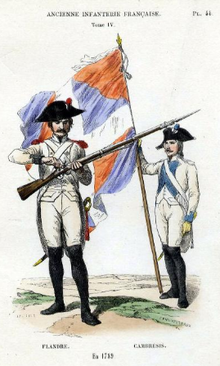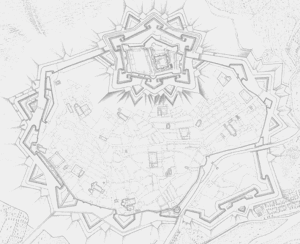Régiment de Cambrésis
The Régiment de Cambrésis was an infantry regiment of the French Royal Army active during the later part of the Ancien Régime before disbanding in 1793 after the French Revolution. The regiment's successor, the 20th Infantry Regiment continues in to serve to this day in the modern French Army as the south-west training unit.
| Régiment de Cambrésis 20éme Régiment d'Infanterie de Ligne (Cambrésis) | |
|---|---|
 Regimental Colours from formation until 1791 | |
| Active | 1776–1793 |
| Country | |
| Allegiance | King of France French Nation |
| Branch | |
| Type | Line Infantry |
| Size | 2 Line, 1 Garrison, and 1 Militia Battalions |
| Headquarters & Recruiting Area | Cambrésis |
| Engagements | Anglo-French War |
Ancien Régime
Background
When Louis XV reviewed the French Royal Army after the end of the disastrous Seven Years' War, he insisted all regiments be equipped and organised the same way. As a result, all infantry regiments of more than two battalions, with some notable exceptions, were divided. The 1st and 3rd battalions disbanded and reformed the old regiment while the 2nd and 4th battalions formed a new provincial regiment and granted a number of precedence just below the former.[1]
Anglo-French War

One example of a split four battalion regiment was the famed Régiment de Flandre. Therefore, in 1776 the 3rd and 4th battalions of said regiment formed the new Régiment de Cambrésis. Unluckily for the new regiments, it had no combat power directly available, as the 1st battalion was in Belle Île and preparing for deployment to sea, while the 2nd battalion was in Saint-Domingue. On 21 May 1776, a uniform ordnance was announced, and the regimental uniform became; white coat, violet facings, violet lapels, pink collar, violet cuffs, and white buttons, and a white trimmed black tricorne.[2][3]

In September 1777, the 1st battalion embarked for Saint-Domingue and joined the 2nd battalion, in preparation for the coming Anglo-French War (American Revolutionary War). The 2nd battalion was in the strategically important port of Môle-Saint-Nicolas (North-West Peninsula) and would remain here until the peace in 1783. In 1779, 50 volunteers under command of Colonel-en-Second the Comte de Durac contributed to the Capture of Grenada and Siege of Savannah, where three officers were wounded. The regiment left the colony on 22 May 1783, and arrived in Brest on 22 July, after a 61-day crossing and moved to Montauban in October. After arriving back in Brest, almost four years after the 21 February 1779 ordnance was announced, a new uniform was introduced which consisted; white jacket, steel grey facings, steel grey lapels, steel grey cuffs, and no buttons.[2][3][4]
Revolution
In June 1785, the regiment moved to Bayonne, and shortly after was separated between the towns of Dax and Bayonne as the revolution escalated it was still stationed here. In 1790, the 1st battalion moved to Navarrenx, and the 2nd went to Orthez, and in January 1791 both battalions left their respective towns for Perpignan.[2]
Following the French Revolution, the provisional regulations of 1 April 1791 grouped all regiments minus the foreign regiments into the same uniform category, and the uniform became; revolutionary blue coat, violet facings, yellow buttons, vertical pockets, black bicorne with the 'revolutionary' cockade of France, and violet collar/cuff flaps. Another thing which changed was the loss of provincial titles, therefore the regiment became the 20éme Régiment d'Infanterie de Ligne (Cambrésis), although most regiments didn't take well to the new change, and maintained the provincial titles well into 1796.[4][5][6]
Perpignan Insurrection
Just as the regiment arrived in Perpignan, the majority of the officers émigrated en-mass into the local Spanish province of Catalonia. The situation worsened as soon very serious disturbing news arrived that officers of the 20th Infantry and 12th Chasseurs à Pied had planned to sneak into the town and deliver the citadel to the Spanish who were approaching from the south-west. During the night of the 6 and 7 December, these officers went to the barracks and attempted to seduce the men; but this odious scheme failed, and in the face of patriotism and courage of the battalion lieutenant-colonel Desbored, who, remained the soldier of their duties, forcing the conspirators to disperse. The regiment then fought bravely during the subsequent Battle of Perpignan. After this scuffle, the lieutenant-colonel was promoted to colonel of the regiment, and the National Assembly Assemblé Nationale issued a decree of indictment against the 27 officers if the regiment.[2]
Shortly after the kerfuffle in Perpignan, the regiment moved to Collioure and joined the garrison shortly after, the 1st battalion then moved to Tarbes and 2nd to Carcassonne. The 1st battalion then joined the Army of the Western Pyrenees Armée du Occidentales Pyrénées and saw much glory in 1793. The grenadiers of the 2nd battalion proved extreme courage on the 22nd of June, during the action of the Mountain of Louis XIV. Later that year, the 1st battalion amalgamated with the 1st and 2nd Battalions of the Lower-Pyrénées Volunteers to form the 39éme Demi-Brigade de Bataille. On 20 October 1793, the 2nd battalion amalgamated with the 3rd Landes Battalion and 3rd Upper-Pyrénées Volunteers to form the 40éme Demi-Brigade. After the 2nd battalion amalgamated, the royal lineage was ended, thus marking the official disbandment of the regiment.[2]
Other Formations
Garrison Battalion
The Garnison Bataillon du Régiment de Cambrésis (Garrison Battalion of the Regiment of Cambrésis) was formed on formation of the regiment, and oversaw the two Dépôts of the regular battalions.[7]
Volunteers
Under the 1776 ordnance, the Bataillon de Péronne was formed and based in the town it was named for, this battalion remained part of the regiment until 1792 when it was disbanded and helped form part of the national volunteers of the same area.[7]
Grenadiers Royaux
The Grenadiers Royaux were originally formed during the Seven Years' War as the active militia of France. They were disbanded following the end of the war, but reformed following the 1776 ordnance with 13 regiments named after the old provinces of France. One of these new regiments was the Régiment des Greandiers Royaux de la Picardie, with its headquarters in Lille, it was formed in 1778 through the amalgamation of the grenadier companies of the garrison battalions of the following regiments; Régiment de Picardie, Régiment de Cambrésis, Régiment de Hainaut, Régiment de Vermandois, Régiment de Flandre, and the Régiment d'Artois. An addition two companies were transferred from the 3éme Régiment d'État-Major. All of the royal grenadier regiments were disbanded on 30 September 1789 by order of the National Assembly, but the troops helped form the first of the national volunteer battalions.[7]
Full Organisation
The full organisation of the regiment in 1779 included:[1][7]
- Regimental Headquarters and Headquarters Depot in Le Cateau-Cambrésis (recruiting from Cambrésis)
- 1st Battalion (Regular Line)
- 2nd Battalion (Regular Line)
- Battalion of Péronne (Militia/Volunteers)
- Garrison Battalion (2nd Line Reserve, Garrison Duties)
Regimental Uniforms
Regimental uniforms throughout the 18th century included:
 Fusiliers uniform under the 1776 regulations.
Fusiliers uniform under the 1776 regulations. Chasseurs uniform under the 1779 regulations (not issued until 1783 due to the regiment being in the West Indies).
Chasseurs uniform under the 1779 regulations (not issued until 1783 due to the regiment being in the West Indies). Fusiliers uniform under the provisional 1791 regulations.
Fusiliers uniform under the provisional 1791 regulations.
Regimental Colours
The provincial regiments of the French army consisted of two colours, the colonel's colours (usually pure bourbon white flag with a slight grey marked cross) and the regimental colours.
 Colonel's Colours Drapeau Colonelle during the Ancien Régime.
Colonel's Colours Drapeau Colonelle during the Ancien Régime. Regimental colours during the Ancien Régime time, in the same colours as the Régiment de Flandre.
Regimental colours during the Ancien Régime time, in the same colours as the Régiment de Flandre. 1st Battalion's colours in 1793, just after the fall of the monarchy.
1st Battalion's colours in 1793, just after the fall of the monarchy. 2nd battalion's colours in 1793, just after the fall of the monarchy.
2nd battalion's colours in 1793, just after the fall of the monarchy.
Commanding Officers
Commanding officers of the regiment included:[2]
- 1776–1780 Jean, Chevalier de Maillé de La Tour-Landry
- 1780–1784 Paul, Marquis d'Angosse
- 1784–1788 Jean-Charles-Théodore, Marquis de Moges
- 1788–1791 Charles-Louis-Secoundat, Baron de Montesquieu
- 1791–1793 Charles-Étienne-Marguerite Desbordes
- 1793–1793 Hyacinthe-Roger Duprat
Footnotes
- Susane, Volume I, pp. 306–307.
- Susane, Volume IV, pp. 46–49.
- Smith, American War of Independence, p. 174–81.
- Lienhart & Humbert, pp. 32, 36, 40, 42, 43.
- Susane, Volume VII, pp. 348–354.
- Smith, Uniforms of the Napoleonic Wars, pp. 42–46.
- Susane, Volume VII, pp. 305, 307.
References
- Louis Susane, Historie de l'Ancienne Infanterie Français, Volume I [in French], 1849 Naval and Polytechnical Military Library of Paris, Paris, France.
- Louis Susane, Historie de l'Ancienne Infanterie Français, Volume IV [in French], 1851 Naval and Polytechnical Military Library of Paris, Paris, France.
- Louis Susane, Historie de l'Ancienne Infanterie Français, Volume VII [in French], 1853 Naval and Polytechnical Military Library of Paris, Paris, France.
- Dr. Constance Lienhart & Réne Humbert, The Uniforms of French Armies 1690–1894; Volume 3: The Infantry, Originally published in 1906, re-printed in 2020, Zanica, Italy. ISBN 978-8893275255.
- Digby Smith, Kevin E. Kiley, and Jeremy Black, An Illustrated Encyclopedia of Uniforms of the American War of Independence, 2017 Lorenz Books, London, United Kingdom. ISBN 978-0-7548-1761-1.
- Digby Smith & Jeremy Black, An Illustrated Encyclopedia of Uniforms of the Napoleonic Wars, 2015 Lorenz Books, London, United Kingdom. ISBN 978-0-7548-1571-6.